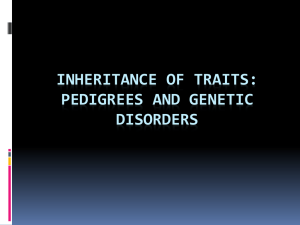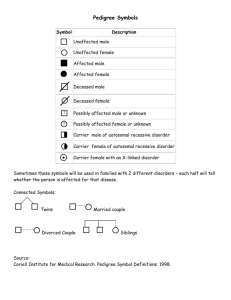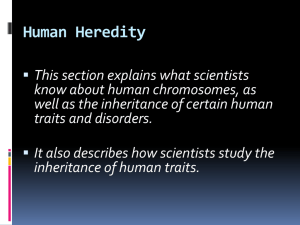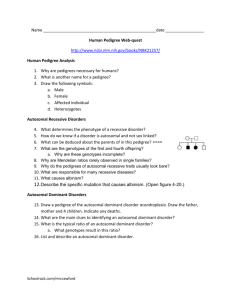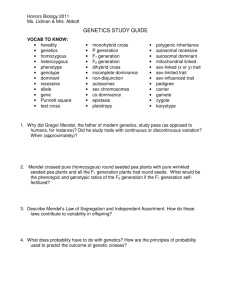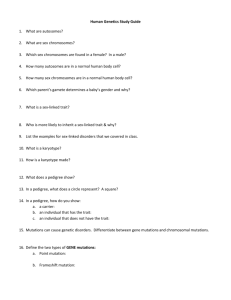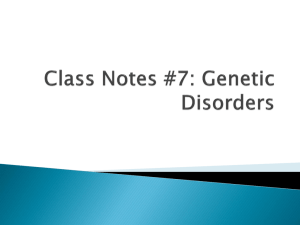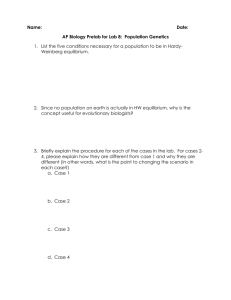NonMendelian Genetics, Genetic Disorders
advertisement
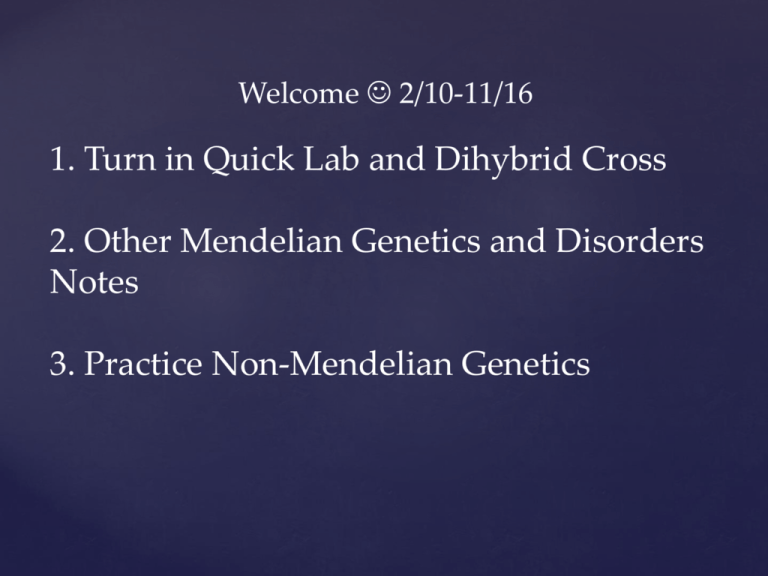
Welcome 2/10-11/16
1. Turn in Quick Lab and Dihybrid Cross
2. Other Mendelian Genetics and Disorders
Notes
3. Practice Non-Mendelian Genetics
Other Mendelian
Genetics, Karytoypes,
and Genetic Disorders
{
Other Patterns of Inheritance
Incomplete Dominance
•
Some alleles are neither dominant nor recessive.
Incomplete dominance: One allele is not completely
dominant over another.
•
Codominance
•
The phenotypes for both alleles are clearly expressed.
Examples: chicken feather color, human protein controlling
blood cholesterol levels
•
Multiple Alleles
Many genes exist in more than two forms.
• Examples: human blood types, fur color in rabbits
•
Polygenic Traits
Many traits are produced by the interaction of
several genes.
• Examples: eye color in fruit flies, coat color in dogs
• Traits typically show a wide variety of phenotypes.
•
Genes and the Environment
Environmental conditions can affect gene expression
and influence genetically determined traits.
phenotype
The
determined by its
of an organism is only partly
.
genotype
Genetics
Disorders
Dominant vs. Recessive
Phenotypic expression on the trait dominantly
Ex: B = Brown (dominant), b = blue (recessive)
BB = Brown
Bb = Brown
bb = Blue
Dominant only require 1 mutant gene of the pair
of chromosome to be affected
Recessive required 2 mutant genes to be affected
Sex-linked
Sex-linked diseases are inherited
through one of the sex chromosomes
(the X or Y chromosome).
Female XX
Male XY
Autosomal
Autosomal diseases are inherited through other
chromosomes rather than sex-chromosomes.
Sex-linked Dominant vs. Sex-linked
Recessive
Sex-linked dominant = mutation on 1 of
the pair of sex chromosome. (XX, XY, XY)
Abnormal gene dominated the gene pair
Sex-linked recessive = mutation on 2 sex
chromosomes (XX or XY)
Abnormal gene on both sex
chromosomes to be affected
One abnormal gene and one normal gene
is not affected but carried
Example of Sex-linked Trait Inheritance
Example
Using a Punnet square to cross a female
who carries a recessive disease on one of
her X chromosome and her husband is
normal.
Is this Autosomal or Sex-linked?
Dominant or recessive?
How will this affect her children?
How many percent of her children are
likely to be affected?
Inheritance of Traits:
Pedigrees and Genetic
{ Disorders
Pedigree definition
Pedigree: a family history that
shows how a trait is inherited
over several generations
Pedigrees are usually used when
parents want to know if they are
carriers of a particular disorder
Making a Pedigree
Female
Male
Married Couple
Siblings
Filled in symbols
indicate
individual is
affected with a
disorder
Example of a Pedigree
Grandparents
Grandparents
Parents
Aunts, Uncles
Aunts, Uncles
Brother
You
Do any disorders run in this family??
Interpreting a Pedigree
What can you tell from a pedigree?
Whether a family has an autosomal or sex-linked disease
or disorder
Autosomal disorder: appears in both sexes equally
Sex-linked disorder: allele is located only on the X
or Y chromosome. Most sex-linked genes are on the
X chromosome and are recessive
So who would have an X-linked disorder more often,
boys or girls?
Whether a disorder is dominant or recessive
Is this disorder 1) autosomal or sex linked,
2) dominant or recessive?
Grandparents
Grandparents
Parents
Aunts, Uncles
Aunts, Uncles
Brother
You
Sex Linked! (in this case
allele is recessive and
located on the X
chromosome)
Is this disorder 1) autosomal or sex linked,
2) dominant or recessive?
Grandparents
Grandparents
Parents
Aunts, Uncles
Aunts, Uncles
Autosomal dominant!
Brother
You
Is this disorder 1) autosomal or sex
linked, 2) dominant or recessive?
Grandparents
Grandparents
Parents
Aunts, Uncles
Aunts, Uncles
Autosomal recessive!
Brother
You
Common Genetic Disorders
Color blindness
Sickle cell anemia
Cystic Fibrosis
Hemophilia
Huntington’s Disease
For more info, go to: http://www.ncbi.nlm.nih.gov/pubmedhealth/
Color Blindness
Deficiency to
percieve colors
Problem with color-
sensing pigments in
certain nerve cells
of the eye
About 1 in 10 men
have some form of
color blindness.
Sex-linked disorder
Sickle Cell Anemia
Disorder where abnormal
hemoglobin (a protein
inside red blood cells) is
produced and warps red
blood cells
Sickle cells deliver less
oxygen to body’s tissues
and can get stuck in small
blood vessels
Recessive trait, tends to
be seen in people of
African or Mediterranean
descent
Cystic Fibrosis
Recessive, autosomal disease
Life threatening, causes thick mucus to build up in various areas of
the body (lungs, digestive tract, etc).
Tends to run in Caucasians, of Northern/Central European descent
(1 in 29 Americans
carry the allele)
Average life span in US
for people with CF is 37,
death usually caused by
lung complications
Hemophilia
Bleeding disorder, where it takes a long time for blood to clot
(body lacks proteins involved in clotting)
Sex-linked
(carried on the X
chromosome)
Treatment
involves
injection with
missing clotting
protein
Huntington’s Disease
Autosomal, dominant
Deterioration of brain tissue,
usually begins between age 30
and 40.
No cure, but have medications
to cope with symptoms
People usually die 15-20 years
after onset of
degeneration

